A friend, dear to many, leaves a legacy of humor, grace, and spiritual insight.
When His Holiness Sridhara Swami left this world on March 14, 2004, it was on his terms in holy Mayapur, surrounded by loving Vaisnavas, and just after he'd helped install Sri Panca-tattva with his dearest godbrothers and friends. He had been terminally ill for years with Hepatitis C, so his departure surprised no one. The memory of his spiritual strength conspicuous in his endless good humor and unfazed by his deteriorating body continues to inspire and fascinate those of us who knew him as we await our appointment with the pyre.
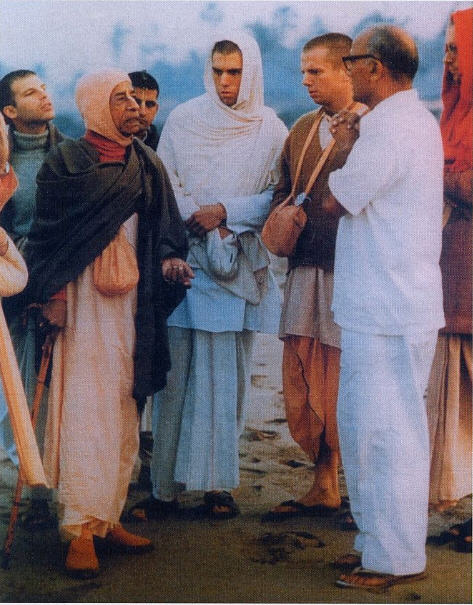
The Bhagavad-gita describes a fully God-conscious death as the highest human achievement. How did this robust, ebullient, sociable Western born world traveler achieve a state of enlightenment more commonly associated with thin, reclusive yogis meditating in a remote Himalayan cave? In Sridhara Swami's life, Srila Prabhupada's sparked a thirty-five-year spiritual journey that began far from its ending point in holy India.
Sridhara Swami described himself as a shy person before coming to Krsna consciousness. Born John Colcleugh in 1948 in Vancouver, Canada, his quest for spiritual understanding led him, in 1969, from engineering school to a Sunday feast at the Frederick Street San Francisco Krsna temple. The first person he met at the door was a kind and energetic devotee named Jayananda Dasa. Since it was early in the day, Jayananda invited his young guest to vacuum the rug and help in the kitchen. By the end of the evening, John was ready for more. He moved in to the San Francisco ashram to begin his study of Srila Prabhupada's Bhagavad-gita As It Is. Later, he transferred to the fledgling Krsna center in his native Vancouver.
In 1970 he returned to San Francisco for the Rathayatra festival and met Srila Prabhupada for the first time. John was deeply impressed and, having completed the required training, was initiated by Srila Prabhupada as Sridhara Dasa Brahmacari. He received more training in cooking, deity worship, and book sales. At one point he led a large group of devotees distributing Back to Godhead magazines to people leaving the popular musical Hair. It was hard for the early-rising devotees to be out so late, but they were happy to find that people were receptive to their message, having just seen Hare Krsna chanted onstage.
Sridhara Swami remembered, "We devotees were very close to each other in certain ways, maybe not maturely, but in the sincerity of desperation. We were trying to rush out of the material world. We had no idea of lifelong devotional service."
Sridhara found he had a strong taste for distributing books, so he joined one of ISKCON's first traveling parties. In Reno, Nevada, he set a record by selling four hundred BTGs in a day. Later he helped open ISKCON's first center in the conservative town of Salt Lake City.
"It was very enlivening and inspiring yet difficult" he said of the experience. "It was an austerity. You're approaching people who think you're weird. You don't know the philosophy that well. Every day you go out in any kind of inclement weather, any environment. It was a hard struggle, but I did well."
Feeling at Home in India
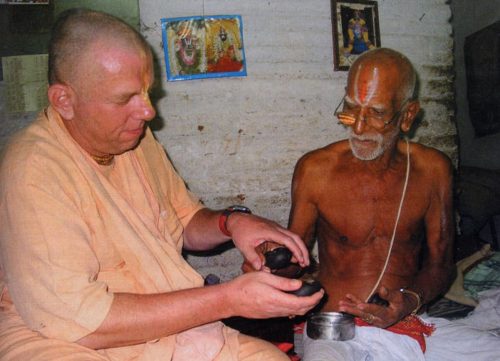
Sridhara and Buddhimanta, another successful young distributor, were sent to London to train others. After some time Sridhara, reasoning he was already halfway there, took an opportunity to visit India. On arriving in Delhi, he found the atmosphere strikingly familiar.
"It was dejm vu," he said. "I felt at home." He served in ISKCON's emerging centers in holy Mayapur and Vrndavana before again joining a traveling party. He and his comrades, headed by Tamal Krsna Goswami, conducted Vaisnava revival programs throughout the country, performing devotional bhajanas (hymns) and speaking to thousands in colorful pandal tents.
By this time, Sridhara Dasa Brahmacari knew what he wanted to do with his life: serve Srila Prabhupada and, specifically, teach Krsna consciousness all over the world. However, in those early days before ISKCON grew widely popular in India, the two goals were not always compatible.
When his traveling party reached Bombay, the young temple was in a critical situation. Srila Prabhupada had bought a large tract of land near Juhu Beach, but now the seller, having taken ISKCON's deposit, was trying to renege on the contract. The devotees had built a temporary temple on the mostly undeveloped land, but the seller, well-connected politically, had influenced municipal authorities to demolish the structure. Conservative Hindus were outraged.
Srila Prabhupada needed capable devotees to stay on the land, rebuild the temporary temple, and battle the deceptive seller in the media and courts. He asked Tamal Krsna Goswami, ISKCON's governing body representative for India, to ask the traveling party to redirect their efforts to Bombay. They agreed, leaving the excitement of the road to share a hut on the raw Juhu land with a tribe of rats, each "big enough to scare any cat." Poverty, mosquitoes, and snakes were constant obstacles.
In the emergency, Srila Prabhupada put the preacher Sridhara in charge of construction material. Sridhara, taking inspiration from young Giriraja Dasa, the temple president, faithfully and obediently carried out Srila Prabhupada's instructions. Through the austerity of his daily life, he worked hard to please Srila Prabhupada, for that was his only ambition. Later, Sridhara Swami said that Bombay taught him discipline and service as the means to attain happiness and to progress in devotional service.
"Disciple," he would often say, "means discipline."
Becoming a Swami
When Sridhara Dasa Brahmacari would enter Srila Prabhupada's room, Prabhupada would sometimes jokingly say, "Here is our Sridhara  Swami." (Sridhara Swami is the name of a great acarya in our line.) When Sridhara asked Srila Prabhupada if he could take sannyasa, Prabhupada agreed and asked him when he would like to have the ceremony.
Swami." (Sridhara Swami is the name of a great acarya in our line.) When Sridhara asked Srila Prabhupada if he could take sannyasa, Prabhupada agreed and asked him when he would like to have the ceremony.
Sridhara replied, "Subhasya sighram," which means that auspicious things should be done at once.
By this time, Sridhara had no interest in family life. Externally he was a jolly, friendly person, but internally he was unemotional about the material world, seeing in it nothing of value for him. India had helped solidify his development and maturity in Krsna consciousness.
"It was very sobering," he later said, "seeing the miserable condition of the material world and the last vestiges of an ancient spiritual culture. India gave me a broad understanding of the tradition and potential of what I was receiving from Srila Prabhupada."
Thus, in Vrndavana, 1975, Sridhara Dasa Brahmacari became Sridhara Swami, accepting vows of celibacy and renunciation that he honored the rest of his life.
After taking sannyasa, Sridhara Swami felt uncomfortable receiving the traditional honor afforded to sannyasis in India. He returned to Bombay and joked with his colleagues, "Where is my maha-prasadam? Where is my maha-prasadam?"referring to special meals traditionally offered to honored guests.
Sridhara Swami thought himself duty bound to return to the West and spread Krsna consciousness, but Srila Prabhupada asked him to stay and help set up ISKCON in India. At that time manpower was scarce; ISKCON had few Indian-born members, and sickness and immigration made staying in India difficult for Westerners. Srila Prabhupada deputed Sridhara Swami to organize temples in Calcutta and, later, Hyderabad, a service he continued until Srila Prabhupada left this world in 1977.
Back to Juhu
Sridhara Swami was in Germany buying a van for the Hyderabad temple when he heard of Srila Prabhupada's departure. He felt, he said, "like a bird flying in the sky who is stunned by the sound of Krsna's flute and just falls to the ground." He was crushed at the thought of living without the company of his beloved spiritual master, whom he had seen regularly through his years of service in India.
Meanwhile, in Bombay, Giriraja Dasa [now Giriraja Swami], under Srila Prabhupada's direction, had led a successful fight to secure ISKCON's Juhu land and build a breathtaking temple. Srila Prabhupada departed just two months before the grand opening. Again, help was needed, so Sridhara Swami was asked to return to help lead and develop the new Radha-Rasabihari Temple in Juhu. He worked diligently there over the next twenty-six years, serving twice as temple president, and helping ISKCON Juhu become one of India's most famous and successful temples.
During his years in Juhu, Sridhara Swami enrolled and cultivated longterm relationships with ISKCON life members. The members loved him and were impressed with his knowledge of Vaisnavism, especially when he spoke in Hindi. Out of deep affection for him and appreciating his friendly, outgoing nature, two members, M. P. Maheswari and Brijratan Mohatta, nicknamed him "the jolly swami."
While enrolling members, Sridhara Swami met many aristocratic industrialists who had little interest in spiritual life. As a renunciant his needs were few, but he was enthusiastic to engage others in giving money for Krsna's service. Such giving helps implant spiritual life in the donors and bring them towards Krsna. Sridhara Swami compared himself to one of Lord Rama's monkeys who helped bring Sita (who is Laksmi, the goddess of wealth) back from the demoniac Ravana. He liked Canakya Pandita's assertion that "one should not be shy about money or prasadam."
The Jolly Inmate
At Juhu in the late seventies a thief was caught stealing and, in the altercation that followed, struck dead by a hired temple guard. The police arrested six temple leaders, including Sridhara Swami, and held them in the hellish Bombay municipal jail for two weeks. During the ordeal Sridhara Swami was a source of strength for all. He spoke enthusiastically about Krsna consciousness to the other inmates and helped the devotees pass the days by holding an imaginary Rathayatra festival, passing around an imaginary ghee lamp, and preparing massive imaginary feasts. The inmates were charmed. By the time the devotees were released, one inmate, a taxi driver, enrolled with Sridhara Swami as an ISKCON life member.
During his decades of service in Juhu, Sridhara Swami developed a deep love for the deities Radha-Rasabihari. Recalling that Srila Prabhupada carried Their photo wherever he went, he did the same.
Paraphrasing a statement of Prabhupada's, in his jovial way he would reflect, "Bombay was Srila Prabhupada's office, Mayapur his place of worship, and Vrndavana his home. For me, Bombay is everything."
Innovative Fundraiser
Although he performed many services in Bombay, Sridhara Swami's most innovative contribution was the establishment of BHISMA (Bhaktivedanta Information Service and Management). In the early '90's, when the technology was just becoming available and was still unheard of in ISKCON and in India, Sridhara Swami set up a directmail fundraising program in Juhu. His investment in the program was met with much skepticism but proved to be highly successful. He went on to extensively study professional fundraising and non-profit management. He spent years traveling throughout the ISKCON world introducing principles and practices he'd learned.
Last year, he founded VAST (Vedic Academy for Spiritual Technology), whose members are academically trained devotees. The aim of VAST is to bring the message of Bhagavad-gita to business people in language and formats that appeal to them.
In recognition of his devotion and expertise, ISKCON's Governing Body Commission (GBC) appointed Sridhara Swami the GBC minister of membership and minister of fundraising. He served in those posts for nearly a decade until ill health forced his retirement. During his time as a GBC member, he expanded his portfolio to include shared responsibility for overseeing ISKCON's temples in Mumbai and the New York City area. Devotees in New York remember him for tackling the demanding and thankless task of cleaning up the large festival area each year after the New York Rathayatra. At the end of the long festival day he would jump to the stage and, with buoyant enthusiasm and good humor, attract and exhort all sorts of volunteers to complete the difficult job. He would perform this duty each year despite struggling with his steadily worsening liver disease.
The Silve Jubilee
Nothing symbolizes Sridhara Swami's courage, devotion, and kindness more clearly than his role in the Silver Jubilee celebration at the Juhu temple in January of 2003. He hatched a plan to gather the Juhu pioneers from all over the world for the event. For several days the magnificent temple was filled with astonishing, emotional, and humorous accounts of the struggles surrounding its birth. Sridhara Swami, who was quite ill, rose from his hospital bed to lead the event. For days he enthralled the large audience by serving generous portions of long overdue appreciation and recognition for the sacrifices of the assembled ISKCON Bombay pioneers.
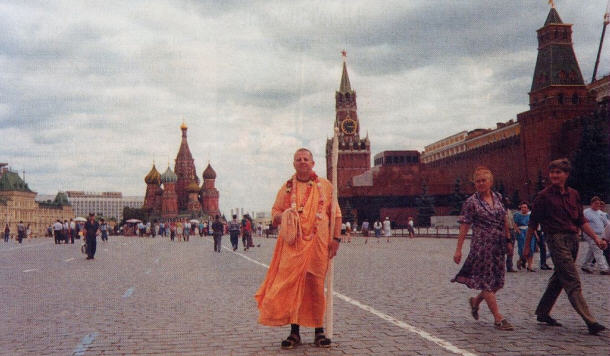
Such was Sridhara Swami's mature realization a hope that ISKCON could continue to evolve from its early struggles into a friendlier, kinder, and gentler institution. Beyond the book distribution, fundraising, and management of his earlier years, he said he considered his primary duty to help ISKCON make and keep Krsna conscious people.
"Losing devotees," he said, "is our real failure."
He was particularly sensitive to the needs of ISKCON youth and helped inspire the founding of Children of Krishna in 1996.
The international ISKCON community felt Sridhara Swami's love and loved him in return. He felt that the devotees' prayers had allowed him an "extension of visa"several years of active service even after his doctors, in 2000, predicted he would be dead in six months. Strengthened by his many well-wishers, he envisioned a Web site through which devotees in difficulty could ask for the blessings of Vaisnavas around the world.
Surely something helped Sridhara Swami survive, as he was less than an ideal patient. Despite the efforts of his loving disciples to get him to follow his doctor's prescribed diet, he would sometimes break it.
Quoting Srila Prabhupada, he would say, "To hell with the starvation committee." He reasoned, "If I eat I'll die, or if I fast I'll die, so I might as well die eating prasadam."
As a further risk, rather than retiring to Vrndavana to die he continued traveling and teaching Krsna consciousness. Wherever he went, his presence was poignant and uplifting.
He liked the positive spirit and would say, "There is no utility in negativity. Pain is inevitable; suffering is an option."
"Pain will be there," he once declared, "but for me it's an education."
Dedicated to Mayapur
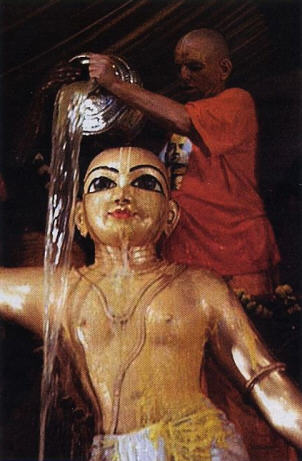
Through his final years Sridhara Swami's great passion remained to see the development of Srila Prabhupada's grand Mayapur project. He constantly sought to inspire devotees to work cooperatively to build the historic temple, which he knew he would not live to see. In 2003 he organized meetings between project chairman Ambarisa Dasa and leading ISKCON life members in Bombay. He gave his disciples names related to Mayapur. And he constantly prayed to his private deities (Ugra Narasimhasalagramas) to tear apart his obstacles so he could dedicate himself uninterruptedly to building Mayapur.
Naturally it was to Mayapur that Sridhara Swami turned as his death became imminent. In January of 2004 he was diagnosed with inoperable liver cancer. After the failure of a last-ditch effort to obtain a liver transplant, he flew, in great pain, from Canada to Mayapur. His elderly mother admonished him that he seemed "too cheerful for someone who is about to die." His two brothers accompanied him and some close disciples and Godbrothers on his final journey.
Sridhara Swami prayed intently to live long enough to attend the historic installation of the Pancatattva deities in Mayapur in February. The trip to Mayapur was arduous and his pain intense, but he survived with help from his friend Indradyumna Swami (See the sidebar "A Hero's Welcome"). As Sridhara Swami finally approached Mayapur, lying in the back of a van, he heard a thunderous kirtana. Hundreds of devotees had gathered to welcome him.
As it turned out, the jolly swami survived those last few days. On the day of the Panca-tattva installation, he again pulled himself from his sickbed and climbed the scaffolding behind the huge deities. With five thousand devotees chanting and cheering uproariously, Sridhara Swami poured the ceremonial liquids over the sacred form of Lord Nityananda.
Days later, on the auspicious day of Srivasa Pandita's appearance, Sridhara Swami peacefully passed away. He left this world as he had lived in it, fixed in devotion to Lord Krsna, who says in the Bhagavad-gita, "One who is thus transcendentally situated at once realizes the supreme Brahman and becomes fully joyful. He never laments or desires to have anything. He is equally disposed to every living entity. In that state he attains pure devotional service unto Me."
Adbhuta Hari Dasa, from Croatia, is a disciple of His Holiness Sridhara Swami and served as his personal assistant.
Kalakantha Dasa, BTG associate editor and author of The Song Divine, writes and raises a family in Alachua, Florida.
Much of the information in this article came from an interview with Sridhara Swami conducted by Arya Devi Dasi for the ISKCON Oral History Project at the Oxford Centre for Hindu Studies.
A Hero's Welcome
This excerpt from Diary of a Traveling Preacher, by Indradyumna Swami, begins outside the Calcutta airport. Indradyumna Swami is helping Sridhara Swami (referred to here as "Maharaja") make his final journey to Mayapur.
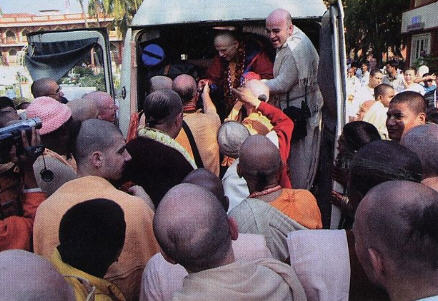
Maharaja's Disciple Mayapur Dasa was waiting outside for us and helped Maharaja to the van that was waiting. We put Maharaja inside and laid him down on a mattress that had been provided for the four-hour journey to Mayapur.
On the way, Maharaja spoke with affection about his disciples. In particular, he reminisced about the service of Mayapur Dasa, his first disciple. It was nectar to hear his reminiscences, but painful as well, for there would not be many more in this lifetime.
We were so absorbed in the discussion that at first we didn't hear the big kirtana on the road leading up to our property in Mayapur. I was the first to hear it, and when I looked out the window, I was stunned. The entire GBC body had come to greet Maharaja, as well as many sannyasis and other senior devotees. Hundreds of other devotees had assembled as well. Everyone was chanting and dancing to a blissful kirtana led by Danavir Goswami.
"Maharaja," I said, "the devotees have come to receive you. Look."
We lifted Maharaja a bit so he could see outside the front window, and when he saw the kirtana party, tears started rolling down his cheeks and he couldn't speak. Then slowly, he recovered his voice. "How I love my Godbrothers!" he said.
Because of the mass of devotees converging on our van, we had to slow down. As we inched our way along, many senior devotees came to the side window of the van to greet Maharaja and pay their respects. It was a touching sight to see the love expressed between Maharaja and these men. He had served alongside many of them through the years, and it was obvious that the camaraderie they had developed in service to guru and Gauranga [Lord Caitanya] ran deep.
We finally drove through the big gates and then up close to the temple of Sri Sri Radha-Madhava. By that time, news of Maharaja's arrival had spread and an even bigger crowd over a thousand devotees had assembled. "A hero's welcome," I thought, "and well deserved."
I helped Maharaja out of the van and began helping him towards the temple to take darsana of the deities. But at one point he pushed me away, as if disturbed that he even needed help. I didn't take offense but rather thought of him as an old soldier, distraught by the fact he needed help. Maharaja had been an active preacher throughout most of his life. He once told me that he would prefer to go down fighting than to die lying in bed with a prolonged illness. A noble sentiment for any preacher, but after a few steps Maharaja began to falter, and I had to catch him to help him along again.
We entered the temple. Maharaja stood before Sri Sri Radha-Madhava and the eight gopis, his eyes focused on their divine forms. He then surprised everyone by raising his arms and dancing a little. Ever intent on learning the art of dying, I watched him intently.
Afterwards several of us helped Maharaja to his room. Many devotees accompanied us, and the room soon filled with devotees wanting to see him. Despite his condition, he was the perfect host, receiving their blessings, words of appreciation, and encouragement.
But soon it became obvious that the long journey from Vancouver and the darsana were taking their toll on Maharaja. His abdomen appeared alarmingly swollen with liquid. A doctor was called, and those who were allowed to remain in the room were very sober as Maharaja lay there with his eyes closed and the doctor checked his stomach with a stethoscope.
Suddenly Maharaja opened his eyes. "It's a boy, Doc," he said. The room exploded in laughter. He was still the jolly swami.
From Diary of a Traveling Preacher, Volume 5, Chapter 16. (To read the full chapter, go to www.krishna.com/385.)
